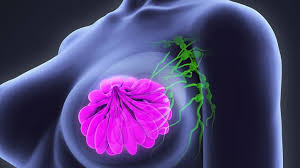Many people may experience subtle or very noticeable changes with the actual skin and appearance of the breast, when they are suffering from many different forms of breast cancer, and it can typically be one of the earliest signs of this type of cancer. The skin may begin to feel itchy, or the patient may experience a tingling sensation across the skin of the breast, along with a redness in color. With inflammatory breast cancer, swelling and a dimpled look to the skin may also occur, due to the blockage of the lymph nodes that may be caused by a tumor or a growth.
2. Lump in the Breast
Of course, the symptom that most people hear about the most is to find a lump or a growth in the breast. This lump may be very small and soft, or it can feel like a hard knot in the tissue of the breast. However, sometimes lumps cannot be felt until cancer has developed into its later stages, which is why it is so important for women over 40 to have regular mammograms. Sometimes small growths can show up in a mammogram, when they are not large enough to be detected by a self-check for lumps in the breast.
3. Swelling
In the early stages of this form of cancer, the breast may look completely normal, even though it has cancerous cells, which is why early detection of breast cancer is so very important for the success of its treatment. As cancer progresses, the breast may begin to swell. The arm on the same side of the body may also be affected by swelling, along with under the arm and the area of the armpit. When the lymph nodes that are located under the arm are cancerous, they begin to swell up, blocking fluids and altering the way that they flow throughout the body, causing the swelling in many different areas.
Learn More at Cancer Connect Breast Cancer Information Center
4. Discharge from the Nipple
During any of the stages of breast cancer, any form of discharge from the nipple can definitely be a warning sign. Nipple discharge is any type of fluid that comes from the nipple, and it can include several different forms. The discharge may be yellow and seem to resemble pus, and it can be very liquid, or it can be thicker in form. The discharge may also take on the color of blood, and it can typically be clear with pockets of blood seeming to “float” in what appears to be a type of mucus. This discharge may or may not be accompanied with pain from the area of secretion.
5. Pain
When a person is suffering from any of the stages of breast cancer, experiencing pain in the breast can generally be a warning sign that should suggest that the patient makes an appointment with a medical professional as soon as possible. As the tumor inside of the breast grows, the pain typically increases, as more and more pressure is placed upon different areas within the chest. When the tumor reaches the skin, it can also cause very painful ulcers and skin abrasions. If the cancer spreads into the ribs, it can cause extreme pain.
Current Breast Cancer Screening & Early Detection Guidelines
Age 30
- Women should be aware of the look and feel of their breasts and report any changes to a care provider as soon as possible. Breast self-exams may help women become familiar with their breasts but are not recommended as a screening tool.
- Women at average risk should have annual mammograms and continuing for as long as the woman is in good health. Recommendations are undergoing a bit of controversy right now-make sure you discuss with your doctor.

No comments:
Post a Comment